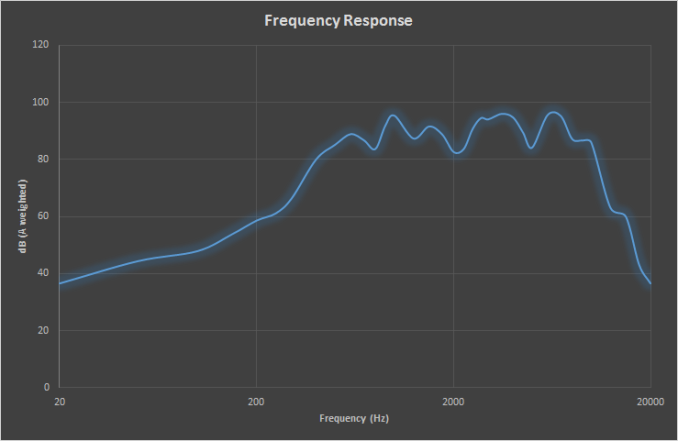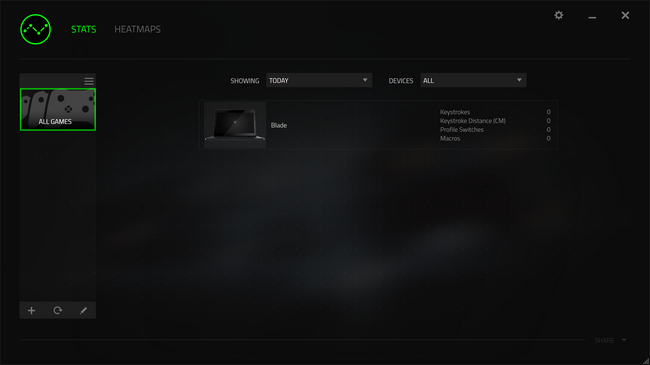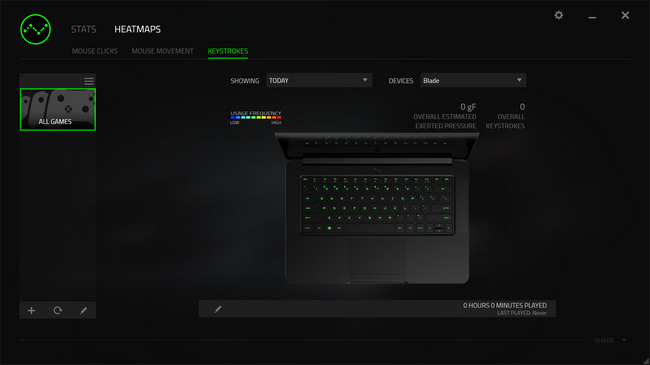The 2015 Razer Blade Review
by Brett Howse on February 11, 2015 2:00 PM EST- Posted in
- Laptops
- Razer
- Razer Blade
- Notebooks
- GTX970M
Speakers
The Razer has two front facing stereo speakers. With laptops this thin, there generally is not a lot of room for good sounding speakers, but I am ready to be surprised at any time. As for overall volume, the new Razer Blade comes in at 83 dBA. The 2014 Razer Blade did not impress me with its speaker quaility, which was disappointing due to not only the cost of the device, but the front facing speakers, which should have an advantage over any system which fires the speakers down, were very poor. With laptops getting as thin and small as they are now, forward facing speakers are less common, so I was looking for more on the 2014 model.
The frequency response for the 2015 Razer Blade is very much improved over the last model. The 2014 model had a very poor curve, and almost no sound at all under 200 Hz. As soon as the first frequency was tested it was obvious that some changes have been made to the speakers. I reached out to Razer, and asked them about the speakers. Although the actual speakers are the same, various subsystems have been changed. Some tuning has certainly been done to improve the overall sound quality, and it has made a big difference. When gaming, headphones will still be necessary to get rid of the fan noise, but for watching movies or listening to music, the speakers are much more usable now.
Software
The only software installed on the system, is Razer’s Synapse software. This in and of itself is worth mentioning due to the huge amount of extra software normally installed on new PCs. On a premium device such as this, it is nice to see that there are no bundled extras to increase Razer's margins. The Synapse software is their in-house software to control the Blade and other Razer peripherals. Razer Synapse has continued to evolve since we last took a look at it. We will not go over what has not changed, so if you want to check that out, it is detailed on our last review here. What is new is a new Stats option on the Synapse software. Opening this goes to some interesting software which lets you keep track of what you are doing while gaming.
Stats, once enabled, will keep track of total keystrokes, distance, profile switches, and macro use, to let you know just what it is you are doing in the heat of battle. And speaking of heat, moving over to the Heatmaps section displays some very cool graphics of where your mouse clicks occur on the screen, where you tend to move your mouse to, and what keys you use the most while gaming. Some of us are certainly not good enough gamers to gain any sort of insight with this data, but it is interesting to look at. For those that want the extra edge, it is a nice addition to the software.
This is what is new on the software, but no software is perfect, nor is any hardware. In future versions of the Synapse software, it would be nice to see some extra features that are missing from the Razer Blade.
First, and previously mentioned, is the lack of any sort of customization of the lighting scheme for the Razer Blade. The green is nice, but there are those of us who like to really make it our own. Alienware has done this for years, and Razer now has some nice looking RGB keyboards which offer some great customization and effects.
The other addition to the software is likely more functional. Fan control should be part of the Synapse software suite on laptops. As much as we like how silent the Razer Blade is doing light duty tasks, almost nothing is more annoying to some people than a fan that ramps up and down, rather than just stay constant. A nice addition would be multiple fan settings, which could be automatically enabled when the GPU kicks in. As we saw in the GPU load graph, there was no throttling at all on the GPU, but the temperature would go up and down like a saw blade. Give me an option to just leave the fans on maximum in that scenario.















116 Comments
View All Comments
fokka - Wednesday, February 11, 2015 - link
i don't think the GPU is swappable on a slim machine like this. afaik, MXM is mostly used in configurable machines like clevo and similar brands.JoshHo - Wednesday, February 11, 2015 - link
The module is integrated into the board and cannot be upgraded or replaced.forwardbias - Wednesday, February 11, 2015 - link
Is the temperature test underload? What about normal usage? Idle?Oxford_Guy - Thursday, February 12, 2015 - link
Under torture-test load, from the sound of itboeush - Thursday, February 12, 2015 - link
Personally, I don't get the attraction of cramped little keyboard, cramped little screen, too much heat and noise, and not enough battery for way too much money.Maybe if Razor, in their infinite wisdom, deigned to build a 17" model with a full size keyboard and a 980m ... then I'd be willing to consider it.
Oxford_Guy - Thursday, February 12, 2015 - link
I have a 13" Macbook Air currently, which is even smaller, and don't find the keyboard cramped at all - I think that's a non-issue unless you have huge hands. Also a 14" screen actually offers a reasonable amount of screen real estate for a portable machine. Those 15.6" laptops with numpad keyboards really aren't that portable, which is the point of a notebook!Battery life is even decent in this for a gaming laptop.
Heat and noise *are* still concerns, however...
sviola - Thursday, February 12, 2015 - link
Razer does have a 17" laptop. It's called the Razer Blade Prohfm - Saturday, February 21, 2015 - link
The keyboard on the Blade is awesome. Not cramped. My guess by your comment is that you're just not the target for their systems. I love it.gtrenchev - Thursday, February 12, 2015 - link
If it wasn't for the stupid logo :)Seriously Razer, it's just childish and tasteless. The only detail that repels me.
Oxford_Guy - Thursday, February 12, 2015 - link
It's not as bad as Alienware and MSI's gaming machines...